Morton’s Neuroma
What is a Mortons Neuroma?
| Morton’s neuroma (also called interdigital or intermetatarsal neuroma) is an injury affecting the nerves that run between the metatarsals (long bones in the forefoot). It most commonly affects the nerve between the 3rd and 4th metatarsal bones, although can occur between any intermetatarsal space. A neuroma is usually caused by compression of the nerve from tight footwear or functional walking problems, which causes the usually thin nerve to thicken and become inflamed. Morton’s neuroma is more common in middle-aged women, people with bunions, or who regularly wear high heels. |
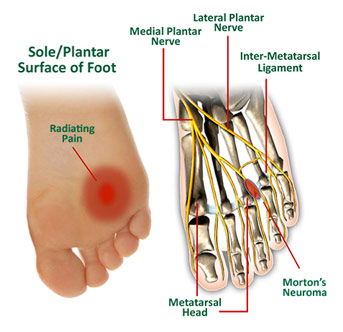
What are the symptoms?
| The most common symptom of neuroma is pain in the ball of the foot just behind the toes that is aggravated by walking and wearing tight-fitting, high heeled shoes. The discomfort may be relieved by rest or wearing cushioned loose fitting footwear. Patients may also describe burning, stabbing or tingling sensations under the ball of the foot, that can radiate into the toes. Sometime a sensation of walking on a small lump or ball under the foot is experienced when a neuroma is present. |
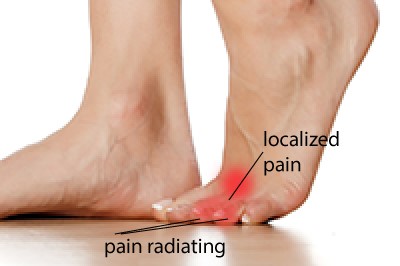
Causes and Risk Factors
| There are many proposed mechanisms of action as a result of compression of the interdigital nerve. One proposed pathological process is the connective tissue around the nerve becomes thickened and fibrotic, changing the protective tunnel into nerve entrapment with ischemia.
Risk factors include: narrow toe-box footwear, hyperextension of the toes in high heeled shoes, deviation of toes, thickening of transverse metatarsal ligament, chronic repetitive trauma, ischemia, entrapment, lipoma, and intermetatarsal bursitis. Foot problems relating to the condition include: flat feet, high arches, bunions, hammertoes and hypermobility. |
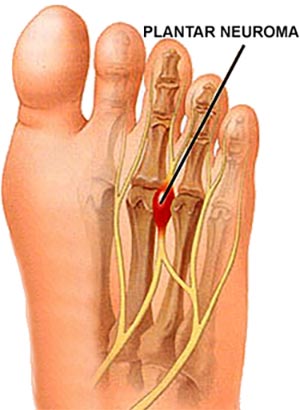
How do we diagnose Mortons Neuroma?’
| Diagnosis can typically be made through taking a thorough history and clinical examination. The most common clinical symptoms were tenderness on direct palpation and pain on weight bearing which was relieved by rest. The most sensitive clinical sign is Mulder’s click. As demonstrated in the picture below it involves compressing the forefoot and palpating just below the toes to produce the sharp, shooting pains. It may be aided by diagnostic measures such as ultrasound scans or MRI.
Morton’s neuroma can often be found concurrently with an intermetatarsal bursitis. Sometimes both a neuroma and bursitis can be present at the same time. |
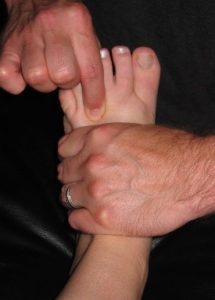
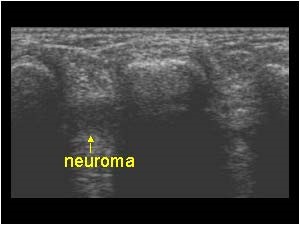
How do we treat Morton’s Neuroma?
Current non-operative treatment strategies include:
If symptoms persist further treatment may include –
In rare instances if non-operative management fails, surgical removal of the neuroma may be required. |

The Podiatry Practice Brisbane Can Help
Our Brisbane Podiatrists are experienced in diagnosing and treating Morton’s neuroma.
Following a comprehensive assessment of your symptoms, foot shape and function, our Podiatrist will discuss the treatment options best suited to you. They may recommend and refer you for an ultrasound scan or MRI scan if there any doubts about the nature of the problem.
At The Podiatry Practice in Brisbane we offer a diverse range of treatment options to suit your needs including custom orthotics and cortisone injections.

Book an appointment today with one of our expert Brisbane Podiatrists. Call 3391 3900.
No referral needed






